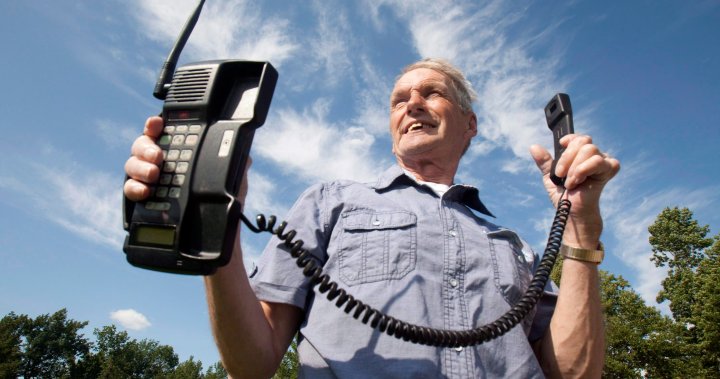The first mobile call in Canada was placed on July 1, 1985 — a deliberately patriotic debut on Canada Day. Then-Toronto mayor Art Eggleton called then-Montreal mayor Jean Drapeau, marking the official birth of cellular communication in our country. The device used that day was hardly the sleek smartphone we mindlessly slip into our pockets today; it was the Cantel 400, a bulky contraption weighing nearly 800 grams with a price tag of around $4,000 (roughly $10,000 in today’s dollars).
As we reflect on four decades of mobile technology in Canada, it’s worth remembering that what we now consider an essential extension of ourselves began as an exclusive luxury. Those early adopters weren’t scrolling through TikTok or ordering Uber Eats — they were simply making calls, at roughly $1 per minute, on devices that sometimes required carrying a separate briefcase-sized battery pack.
“The early cellphones were status symbols, not utilities,” explains Dr. Melissa Vincent, technology historian at McGill University. “Only executives, doctors on call, and the wealthy could justify the expense. The idea that children would someday have their own mobile phones would have seemed preposterous.”
The transformation from novelty to necessity happened gradually, then suddenly. By the mid-1990s, cellphones had shrunk considerably in both size and price. The iconic Nokia 5110 with its revolutionary Snake game became many Canadians’ first introduction to mobile entertainment. Companies like Fido and Clearnet (later absorbed by Rogers and Telus) expanded coverage and brought competitive pricing that pushed mobile adoption beyond urban centers.
The BlackBerry revolution marked Canada’s most significant contribution to global mobile culture. The Waterloo-based Research In Motion created devices that transformed how business was conducted worldwide. For a brief, shining moment, Canada led the smartphone revolution, with our homegrown “CrackBerry” becoming so essential to professional life that even Barack Obama refused to surrender his upon becoming U.S. president in 2009.
“BlackBerry represented Canadian innovation at its finest,” notes technology analyst Jean Tremblay. “It showed we could compete globally in cutting-edge tech. Unfortunately, the company failed to anticipate how quickly touchscreens and app ecosystems would revolutionize the industry.”
Indeed, the 2007 introduction of the iPhone fundamentally changed our relationship with mobile technology. Suddenly, the phone aspect of the device became almost secondary to its other capabilities. Social media, mapping, photography, banking, dating, fitness tracking — entire industries were disrupted as these functions migrated to the supercomputers in our pockets.
The societal impacts have been profound. Mobile technology has democratized content creation, connected remote communities, revolutionized emergency response, and transformed how we navigate both physical spaces and social relationships. A 2023 Statistics Canada report revealed that 99% of Canadians between 15 and 34 now own a smartphone, with overall national adoption exceeding 90%.
Yet this transformation hasn’t been without consequences. Screen addiction, privacy concerns, digital divides, and environmental impacts from production and e-waste present significant challenges. The modern smartphone contains dozens of materials sourced globally, often under questionable labor conditions, creating ethical questions about our collective tech dependency.
For Indigenous communities in Canada’s North, mobile technology arrived later but has become vital for cultural preservation and overcoming isolation. “Smartphones have allowed us to document traditional knowledge and connect youth with elders in ways previously impossible,” explains Inuit technologist Sarah Koonoo, who develops language learning apps. “But we’re still fighting for the infrastructure equity that southern Canadians take for granted.”
Looking ahead, 5G networks promise to usher in yet another revolution in how we use mobile technology, with augmented reality, autonomous vehicles, and the Internet of Things poised to further blur the boundaries between digital and physical realms. Canadian telecom companies have invested billions in this next-generation infrastructure, though rural coverage remains a persistent challenge.
What began as a luxury item for the elite has become so thoroughly integrated into Canadian life that temporary network outages now qualify as national emergencies. The smartphone has evolved from a revolutionary technology to a mundane necessity, something we notice only when it’s not working properly — perhaps the ultimate marker of how essential it has become.
As we mark four decades of mobile communication in Canada, perhaps the most remarkable aspect isn’t the technology itself, but how completely it has transformed us. From business to education, healthcare to entertainment, romantic relationships to family dynamics — no aspect of Canadian life remains untouched by the devices we now take completely for granted.
Will we look back at today’s smartphones with the same bemusement we now direct at those brick-sized pioneers? Almost certainly. The only question is what unimaginable technology will have replaced them.
For more perspectives on technology’s impact on Canadian society, visit our CO24 Culture section, or explore emerging digital trends in our CO24 Trends coverage.










